Beyond their studies and legal practise, many members of the Middle Temple have, throughout history, enjoyed playing sports in their leisure time. The Inn itself has founded sporting events and societies, while individual members have competed professionally in sports, such as cricket, at both club and international level.
Tennis has long been a popular past time for members, with the Middle Temple grounds once having their own tennis courts, located in the garden. It is notable that the Middle Temple Lawn Tennis Club is considered to be one of the oldest in England, having been founded in 1878. However, there is evidence that members were playing before the club’s formation, as in this image below from 1861, showing tennis being played in the gardens in front of the old Victorian library.
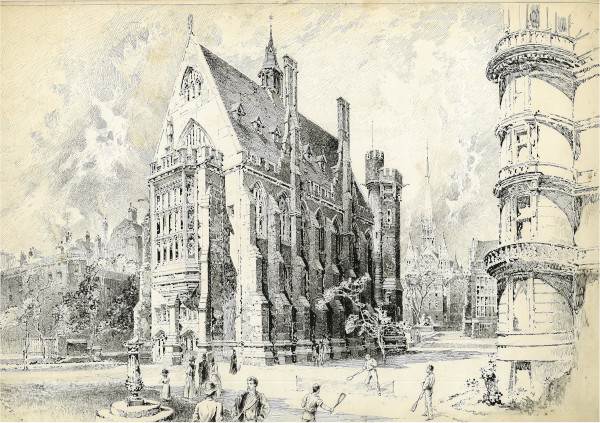
Members playing Tennis outside the Victorian Library at Middle Temple [MT/19/ILL/D/D1/48].
During World War II, the Inn’s tennis courts were removed to make way for allotments. After this, the post-war rebuilding of the Inn only allowed room for one court (instead of the previous two) and along with the disfigurement of the lawn, a decision was made not to allow any further play. Following this announcement, the Tennis Club wound up at ‘a sparsely attended general meeting’ on 27 March 1953, with a decision to leave the remaining club funds in the bank.
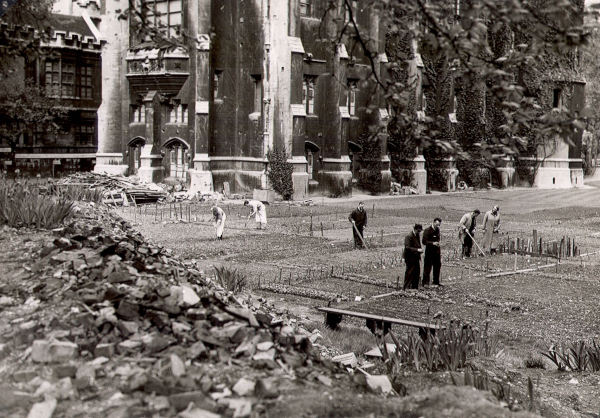
Allotments in the Middle Temple Gardens during World War II [MT/19/PHO/4/12].
As time wore on, some members of the Inn looked into bringing back the tennis club and courts. They stated that enquiries had shown that many Middle Temple Barristers would welcome the creation of, and actively use, the courts - especially as members were currently having to travel to Regents Park if they wished to play. In 1967, a proposal was put forward to reinstate both the club and courts after approval was given from the Master of the Garden and the funds from the old club were allowed to be used. However, due to the eventual lack of funds versus cost and declining interest, the project did unfortunately not go ahead.
The garden lawns by Hall, however, were already being optimised by the Middle Temple Lawn Bowls Club, founded in 1961, which held a robust membership of over fifty people in the first year alone. The club was subject to the notion that “bowls is strictly a game for older men (and women).” This did not, however, faze Thomas Banks, the Junior Vice President, who in 1961 wrote an open letter to the Guardian, pointing out that the national singles bowls champion was under 30 and that the Middle Temple Bowls Club welcomed players of all ages.
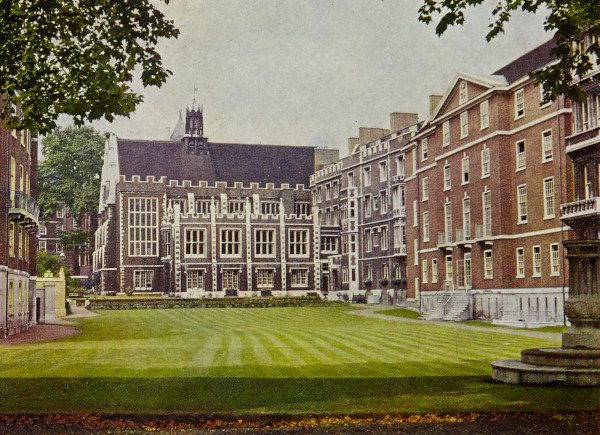
Middle Temple Lawn [MT/19/ILL/D/D1/43b].
Golf has for many years been a popular past time for members, evidenced by The World of Golf Journal writing to the Inn in 1906, asking them if they would like to subscribe to the magazine for the benefit of their members. They believed that a subscription, in light of the popularity of golf amongst the Inn’s members, would be “a popular addition to the common room.” However, it appears that Middle Temple did not see much value in the subscription and did not take up the offer.
The World of Golf letter to the Middle Temple [Box XXIII - Bundle VII].
Golf was, and continued to be, nonetheless, a big part of life at Middle Temple. In 1921 a golfing competition was founded by Sir Thomas Edward Scrutton in which the four Inns of Court all competed in teams to win ‘The Scrutton Cup’. Scrutton himself was Called to the Bar at Middle Temple in 1882, going on to become a Bencher in 1908, with a personal passion for golf, so it is of no surprise that he set up this tournament which is still hosted by the Bar Golfing Society to this day. Following the introduction of the Scrutton Cup, the Middle Temple Golfing Society was formed in 1923 by Lord Scrutton and their many matches and competitions were held on courses near London at 5pm in the summer months so to “cause minimum interference to working hours.”
The Middle Temple Golf team have had moderate success in the Scrutton Cup, having won twenty-one times over the last one hundred years, in an event that has only ever paused for World War II and the Coronavirus pandemic, with the Middle Temple’s best winning run lasting from 1928-1932. In honour of winning the Cup in 1958, after twenty-four years without victory, a dinner was held in honour of the Middle Temple Golfing Society at the Inn. Later in 1980, another dinner was held to celebrate the victory of Middle Temple in the Scrutton Cup, after fourteen years without a win, at which members of the winning team were invited to dine in the Queen’s Room.
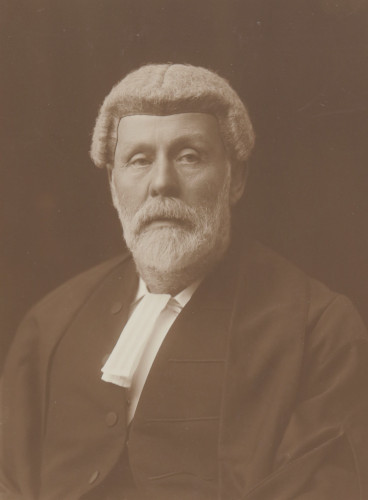
Portrait of Lord Scrutton [MT/19/POR/636].
It was not only members who established sports clubs and competitions: the Inn’s students have also been known to form their own sports societies. For example, the badminton club was founded in Hilary Term of 1959 and the Inns of Court Cricket Club was formed in 1957 by members of the four Inns.
However, it soon became clear that the cricket club was expensive to run; the President claimed that a minimum of £40 a year was required to cover the costs of “the kit, balls, hire of the ground and the various other expenses which go with cricket.” Therefore, the club requested financial help from the Inn in order to continue competing and allow them to host home games, stating that it was “humiliating as well as frustrating and boring to play the part of guest all the time.” Nevertheless, despite the club’s limited resources, they performed very well, only losing two out of ten matches they played in the 1966 season. The Cricket Club played a range of teams across the summers, as the fixture list for 1967 shows, travelling to various locations within the country and staged an Inter-Inn cricket match for students.

Middle Temple Cricket Club fixture list for the 1967 season [Box C - Bundle 1].
The Students’ Association also hosted a one-off event in 1989 known as the Middle Temple Dash in which there were two races, a Gentlemans race and a Ladies race. A trophy was presented to the winner of each, James J. Hargan and Cathy Gordon, whose names were subsequently inscribed on their trophy.
The Middle Temple Dash Cups.
Outside of the Inn, many members have participated in sports, both recreationally and professionally. Cricket was one sport that saw a wealth of members play professionally for club and country both alongside and after their studies.
One such member was Learie Constantine. Born in Trinidad, he briefly embarked on a legal career before this was overtaken by his glittering career in professional cricket, playing for the West Indies Cricket team and several English clubs. He returned to law in 1944, the year he was admitted to the Inn, but continued to play alongside, also moving into writing and broadcasting within the sport. Constantine also became the first black man to sit in the House of Lords.
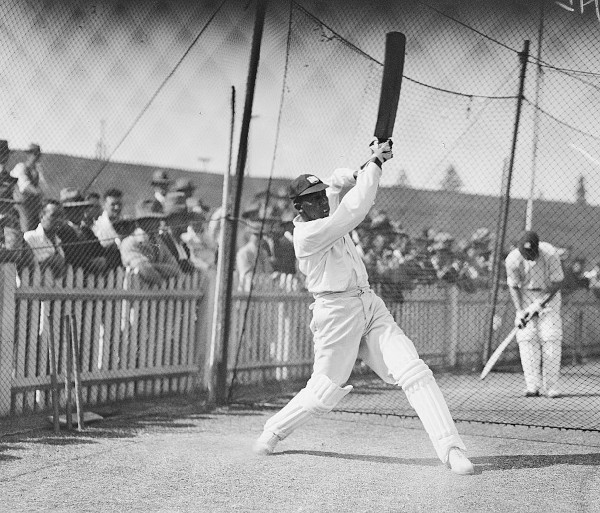
Image of Learie Constantine playing cricket.
Cyril Rutherford “Snuffy” Browne, born in Barbados in 1890, was a keen cricketer alongside his legal career, having been Called to the Bar in 1914. He played first class cricket for Barbados and British Guiana from 1909-1938 and was a member of the first West Indies Test cricket team, playing against England in 1928. Browne went on to become the first black West Indian to be elected as an honorary life member of the Marylebone Cricket Club.
John Idowu Conrad Taylor was born in Lagos, Nigeria and moved to England to complete his studies, where he was noted as a ‘fine sportsman’, excelling in a range of sports, particularly cricket. Taylor was admitted to the Inn in 1937, returning to Nigeria to join his father’s law firm after having been Called to the Bar in 1941. He continued to play sport when back in Nigeria, captaining the national cricket team between 1947-49.
Outside of cricket, one avid sportsman was Edmund Bartley-Denniss who was not only a barrister, but also a keen cyclist, seen as a pioneer of the sport in Britain. While studying at Oxford University, he was an original member of the Dark Blue Bicycle Club founded in 1873 with the aim of holding meets and races and to be centrally involved in shaping bodies to organise both competitive and recreational cycling in England and Wales.
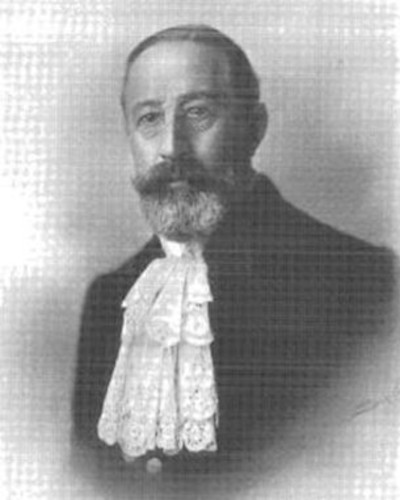
Image of Edmund Bartley-Denniss.
Middle Templars have also excelled athletics, one outstanding athlete being Ralph Kilner Brown, Called to the Bar in 1934. Brown was a British 440 yards hurdles champion and competed at several international meetings on the continent. After winning bronze at the 1934 Empire Games, an injury unfortunately prevented him from taking his place at the 1936 Berlin Olympic Games. Brown was elected a Bencher of Middle Temple in 1964, knighted in 1970 and was Reader of Middle Temple in 1982, in which he gave an address, later published, entitled The Office of Reader in the Middle Temple. Likewise, Blondel Thompson, elected to become a Bencher of the Inn in 2017, was a former British and Commonwealth record-holder in the 100m hurdles, who now specialises in sports law, crime, and regulatory work. Thompson is also an Arbitrator for the Football Association and panellist for Sport Resolutions’ Safeguarding Children in Sport.
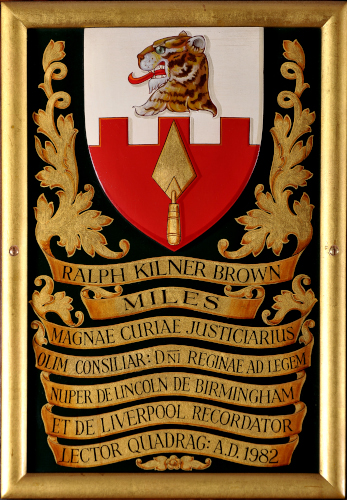
Armorial Panel of Ralph Kilner Brown.
Similarly, Peter Curry was a long-distance runner and represented Great Britain in the 1947 World Student Games, finishing fourth in the three-mile race, going on to win the 3000-metre steeplechase at the 1948 AAA Championships being selected for the Olympics in the same year, but unfortunately did not make the final. Curry went on to have a legal career instead, being Called to the Bar at Middle Temple in 1953 and taking silk in 1966.
Over its history, Middle Temple has maintained strong connections to the world of sport, through its students, members, and societies within the organisation, showing that is possible for one to have a successful legal career, while also participating professionally in sports: a connection which we hope will continue in years to come.